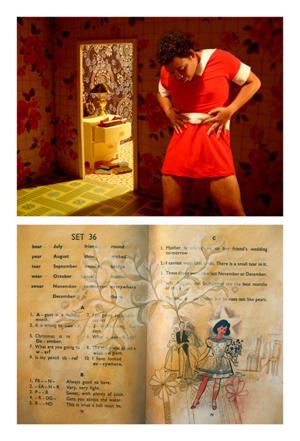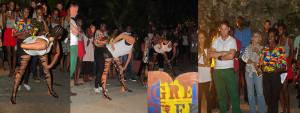
Alberta Whittle
From the boat to de Club ah Bubble
2012
With the highest number of churches per square mile, it is a fair deduction to say that Barbados has a strong (religious) moral compass. In 2012 just under 80% of the population stated affiliation with a religion1, mainly a vein of Christianity. One of the aspects of Christianity is the strict perception of gender and sexual relations, especially in the lack of tolerance for homosexuality. This also filters into the Barbadian legal system: anyone caught in a homosexual act can face life imprisonment. Juxtaposing with this traditional moral mindset (though still strictly intolerant of same-sex relations), contemporary gender stereotypes of male and females are also emerging in the hypersexual portrayals of Dancehall ‘fete’ culture in the island. But the common ground remains: it seems to be a Barbadian female is to adhere to the stereotype whether that is a traditional pious domestic goddess or a contemporary sexually charged, scantily clothed “rude gal”; similarly it seems to be a Barbadian male is to be a religious white collar breadwinner and head of the household, or a contemporary hustling, baggy-jean wearing “rude boy”. However, two artists from the island appear to be highlighting and challenging these stereotypes in their recent bodies of work, opening up discourse on the subject and providing a space where our cultural stereotyping can be critiqued.

Ewan Atkinson
I cannot wear this dress
2005
Visual artist Ewan Atkinson’s work has been exhibited in France, the UK, Trinidad and throughout the U.S.A, in addition to Barbados. A recurring theme in Atkinson’s oeuvre is sexuality stereotyping, questioning the values held towards gender roles in the Caribbean, and often inserting himself into the piece, emphasizing the identity displacement that can result from such rigid gender structure. For example, in his body of work, Playing House (2005). Using colonial educational texts previously distributed in Barbadian schools, Atkinson re-constructed domestic scenes in a doll house, then inserted himself via digital rendering as the textbook characters, mainly as a girl wearing a red dress. I cannot Wear this Dress (fig.1) illustrates his challenging of societal values placed on gender representation, and his exclusion from these roles. In the image he is a man wearing a dress. But under traditional conventions, he is also aware this is not a socially acceptable option in Barbados, for the man in the household to be wearing the dress. Having the excerpt of the referenced text directly under his constructed image, Atkinson implies that this conservative mindset in colonial education could be a prerequisite to the gender-conservative contemporary Bajan society.

Ewan Atkinson
Untitled
2011
Another recent work, a submission to the Projects and Space’s 2011 Plywood Project, sees a comment on freedom of a nation and freedom of national identity in Barbados (fig. 2). This portrait conveys his reservations about two main parts of self- his national heritage as a ‘free’ Barbadian, and his restrictive role as a male. A reference to education in the notepaper appears to encompass the image where Atkinson is comparing what he has been taught he should represent, and what he personally represents. The insertion of the Bussa figure, a symbol of freedom in Barbados, is amongst a crown of foliage on a bust of himself wearing makeup and confronting the viewer. Why in contemporary Barbados is a man not at liberty to have a different sexual orientation other than heterosexual… in such an oppressive manner that it is actually illegal to express homosexual tendencies? Are homosexuals / bisexuals/ transgenders not included in the national identity sphere – is it “un-Bajan” to be gay? These challenges to social identity ooze from the work and ultimately open discourse on the relationship between sexual orientation and gender stereotyping in the island.

Alberta Whittle
Hustle de money
2012
Looking at a similar thread of themes, Alberta Whittle’s most recent installation / performance piece highlights the hypersexuality in Barbados’ ‘fete culture’ and the implications of the gender stereotypes associated with this. An MFA graduate of the Glasgow School of Arts, Whittle recently completed a three-month residency at the non-profit arts platform Fresh Milk in Barbados at the end of 2012. The result of this residency was the piece Hustle de Money – a Performance by Bertie aka Big Red aka De General outta Glitter Zone. Drawing inspiration from fete advertisement posters around Barbados, in particular the capital Bridgetown, Whittle reconstructed an advertising campaign and fete scenario at the Fresh Milk compound. This included an abundance of re-interpreted posters featuring herself as both the female and male characters in the advertisement, and a performance as both of these gender stereotypes. The posters acted as direct social commentary to the overt sexual nature of fete advertisements seen. For example in From de Boat to de Club Gals dem ah Bubble (fig.3) Whittle poses as the provocatively dressed female character “Shakira aka Reds aka Hookie outta Champagne Babies” as well as the aloof male figure “Shotta”. The titles of the fetes are lyrics from popular Dancehall songs throughout the Caribbean, and the inserted imagery of champagne bottles and gold bars and wads of cash represents the American ‘hip-hop lifestyle’ influence. In them, the women are always posing in a sexual manner, and the men are always standing in confrontational ‘thug’ poses. Whittle expresses her intentions in these posters, stating: “Aware of my own inability to truly present as masculine, I aim to poke fun at these stereotypes and show the obvious signs of masquerade behind these actions”2 .
During the performance aspect of the piece (fig. 4 & 5) Whittle “enacted movements and recited phrases suggestive of the over-wrought and fetishistic machismo of Caribbean ‘fete’ and street-culture. Each sequence started and ended with the artist emerging from or returning to the cover of the screen, where she would adjust her costume (alternating between male and female identities: torn up black tights for the female, simple track-pants for the male).” 3The performance acted as an interactive installation, where the audiences also became part of the Dancehall scene as Whittle gyrated on them and got them to pile bananas on her. Bananas being both a phallic symbol and a symbol of a stereotypical Caribbean export commodity…something which Caribbean gender is implicated as through Dancehall. By being both the man and the woman in this sexual exploitation culture scenario, Whittle comments on the fluidity of seemingly rigid roles dictated by fete culture that contemporary Bajans must adhere to in order to fit in these fetes.
So can these artists’ critique of gender stereotyping in Barbados really mean the dissolution of it? In an abstract way Atkinson and Whittle do exemplify that creating a consciousness of gender roles expected in society already sets in motion the break down of those roles. And therefore this can lead the way in generating a more diverse spectrum of male and female representations under the umbrella of a Barbadian national identity.

